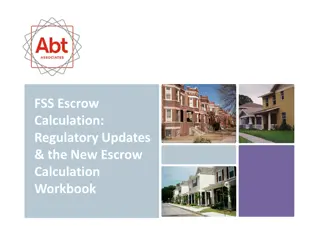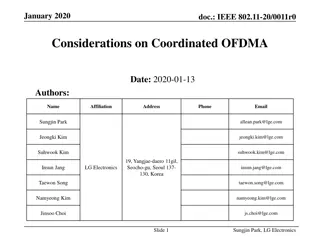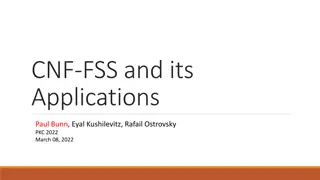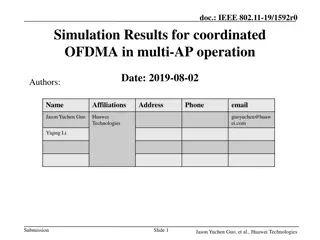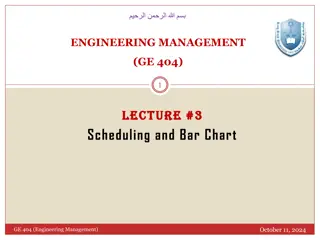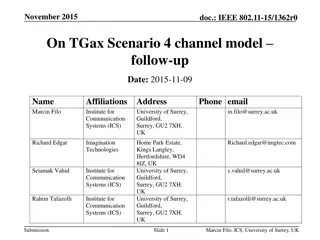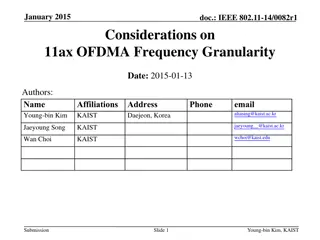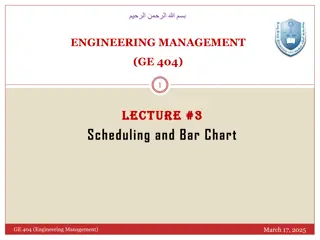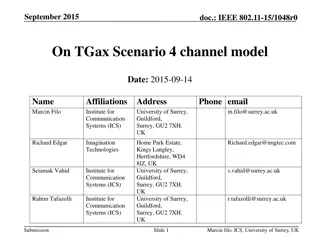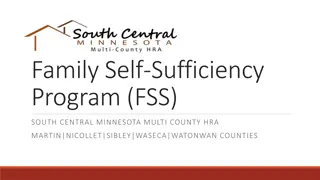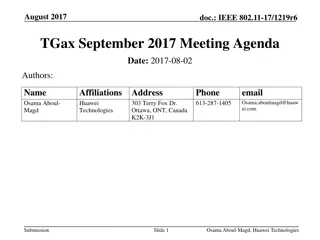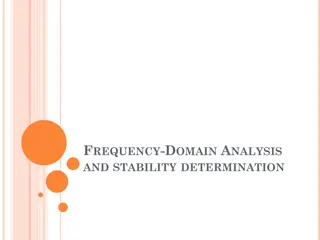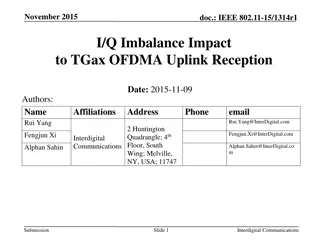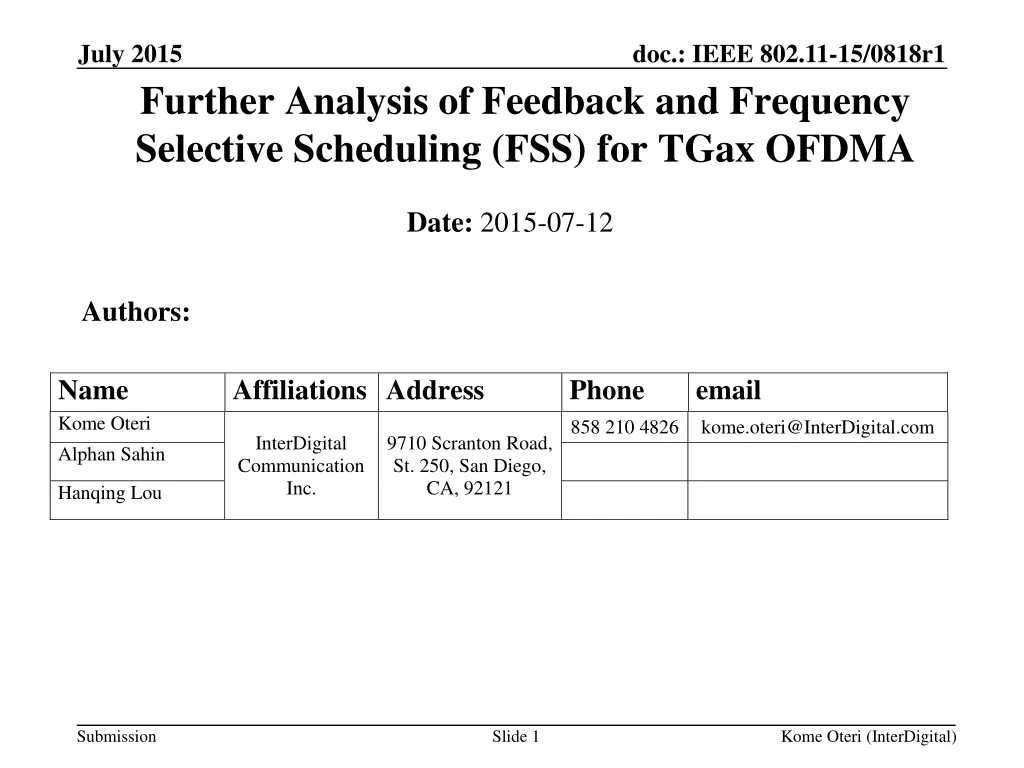
Analysis of Feedback and Frequency Selective Scheduling for TGax OFDMA
This document explores the potential gains in resource unit selection for OFDMA transmissions using different granularities, channels, and simulation scenarios in the context of TGax. It studies the impact of feedback granularity, resource unit granularity, quantization, latency, and feedback overhead on these gains, emphasizing the need for efficient RU-based feedback mechanisms.
Download Presentation

Please find below an Image/Link to download the presentation.
The content on the website is provided AS IS for your information and personal use only. It may not be sold, licensed, or shared on other websites without obtaining consent from the author. If you encounter any issues during the download, it is possible that the publisher has removed the file from their server.
You are allowed to download the files provided on this website for personal or commercial use, subject to the condition that they are used lawfully. All files are the property of their respective owners.
The content on the website is provided AS IS for your information and personal use only. It may not be sold, licensed, or shared on other websites without obtaining consent from the author.
E N D
Presentation Transcript
July 2015 doc.: IEEE 802.11-15/0818r1 Further Analysis of Feedback and Frequency Selective Scheduling (FSS) for TGax OFDMA Date: 2015-07-12 Authors: Name Kome Oteri Alphan Sahin Affiliations Address Phone email 858 210 4826 kome.oteri@InterDigital.com InterDigital Communication Inc. 9710 Scranton Road, St. 250, San Diego, CA, 92121 Hanqing Lou Submission Slide 1 Kome Oteri (InterDigital)
July 2015 doc.: IEEE 802.11-15/0818r1 Outline Motivation Feedback Granularity (FG)/ Resource Unit Granularity (RG) System Throughput Simulation Assumptions System Throughput Results Effect of Quantization, Feedback Overhead and Latency Conclusions References Submission Slide 2 Kome Oteri (InterDigital)
July 2015 doc.: IEEE 802.11-15/0818r1 Abstract This contribution quantifies the potential resource unit (RU) selection gains for OFDMA transmissions for different granularities, TGax channels and TGax simulation scenarios. The effects of feedback granularity (FG), RU granularity (RG), quantization, latency and feedback overhead on the selection gains are studied. The gains achieved from RU scheduling for TGax OFDMA motivate the need for efficient RU-based feedback. Submission Slide 3 Kome Oteri (InterDigital)
July 2015 doc.: IEEE 802.11-15/0818r1 Motivation The 11ax specification framework has already defined UL/DL OFDMA as one of the key 11ax MU features [1]. An RU numerology has been agreed upon [4] OFDMA may exploit the channel selectivity to maximize frequency selective multiplexing gain in dense network conditions [5][6][7][13]. Results from [13] are updated based on the newly agreed numerology [4] We quantify the gains for resource unit (RU) scheduling in OFDMA transmissions over different TGax channels [2][3] in different TGax simulation scenarios [8] using different RU/FG granularities for different feedback SNR quantization levels for different feedback latencies Submission Slide 4 Kome Oteri (InterDigital)
July 2015 doc.: IEEE 802.11-15/0818r1 Granularity Definition @ Receiver: Instantaneous rates on the sub-channels (based on feedback granularity (FG)) are calculated and fed back to the transmitter. @ Transmitter: Instantaneous rates on the RUs (based on RU granularity (RG)) are calculated for each station and proportional fair scheduling is performed. Other users may use different granularity. Submission Slide 5 Kome Oteri (InterDigital)
July 2015 doc.: IEEE 802.11-15/0818r1 RG and FG for 20 MHz and 80 MHz Feedback granularity (FG): RU granularity (RG): 20 MHz Granularity Feedback granularity (FG): RU granularity (RG): 80 MHz Granularity Submission Slide 6 Kome Oteri (InterDigital)
July 2015 doc.: IEEE 802.11-15/0818r1 System Throughput Simulation Assumptions No MAC protocol overhead assumed STAs are located based on specific TGax simulation scenarios [8] Non-continuous resource allocation was allowed Table derived from [8] Submission Slide 7 Kome Oteri (InterDigital)
July 2015 doc.: IEEE 802.11-15/0818r1 Exemplary Simulation Results (20 MHz): SS1 Throughput Random vs PF Gain (%) FG: Case1 to Case 4; Channel D FG: Case1 to Case 4; RG: Fixed (Case 4) RG determines the throughput performance. FG should match RG For a fixed RG, throughput saturates with increase in FG based on channel type Ch B:large initial gains, saturates quickly/ Ch D/Umi: gains saturate more slowly Submission Slide 8 Kome Oteri (InterDigital)
July 2015 doc.: IEEE 802.11-15/0818r1 Exemplary Simulation (80 MHz): SS1 FB Granularity : Case1 to Case 6 Random vs PF Gain (%) FG: Case1 to Case 6 Channel Model: Channel D RG: Fixed (Case 6) Channel Model: Channel B/D More gain in 80 MHz than 20 MHz due to large frequency selectivity available Similar saturation behavior and RG/FG relationships as 20 MHz transmission Appendix: Large system throughput gains for scenarios with low baseline throughputs SS3 40% (20 MHz); SS3 45 %(80 MHz) ; SS4 60% in 20 MHz transmission Submission Slide 9 Kome Oteri (InterDigital)
July 2015 doc.: IEEE 802.11-15/0818r1 Quantization, Overhead and Delay 802.11ac MCS Feedback Mechanism (VHT variant HT Control field) as baseline MCS Feedback (MFB) field contains: NUM_STS: recommended number of Space Time Streams VHT-MCS: recommended MCS; unsigned integer from 0 to 9 BW: bandwidth for which the recommended VHT-MCS is intended unsigned integer from 0 to 3 SNR: SNR averaged over all data subcarriers and space-time streams 6-bit integer covering -10dB to 53 dB in 1 dB steps Submission Slide 11 Kome Oteri (InterDigital)
July 2015 doc.: IEEE 802.11-15/0818r1 Effect of Feedback Quantization Quantify effect of SINR quantization on scheduling gains 20 MHz: FG = RG = 9 RUs 80 MHz: FG = RG = 37 RUs Case1: 1 bit; Case2: 3 bits ; Case3: 6 bits; Case4: No quantization SINR value quantized and fed back to the transmitter. [-10,53] dB mapped to 2N -1 values 6-bit quantization of SINR for each RU (equivalent to MFB:SNR quantization in 802.11ac [14, Table 8-13b].) is sufficient to extract scheduling gains Submission Slide 11 Kome Oteri (InterDigital)
July 2015 doc.: IEEE 802.11-15/0818r1 Feedback Overhead Quantify feedback overhead in number of OFDM symbols assuming MCS0 transmission and 802.11ac MFB mechanism 1 additional OFDM symbol needed for 20 MHz with 4 to 9 FB granularity 3 or 4 additional OFDM symbols needed for 80 MHz with 21 FB granularity no performance loss compared with 37 FB granularity Submission Slide 13 Kome Oteri (InterDigital)
July 2015 doc.: IEEE 802.11-15/0818r1 Latency - Simulation Scenario 1 @ 20 MHz Quantify effect of latency between feedback measurement and scheduling on scheduling gains Case1: ? = 5 ? Case2: ? = 4 ? Case3: ? = 2 ? Case4: No latency FB Granularity : Case 4 RU Granularity: Case 4 Bandwidth: 20 MHz Quantization: Ideal Number of users: 5 T = Duration(NDPA) + Duration(NDP) + Duration (Feedback) In this scenario, latency does not affect scheduling gains Submission Slide 13
July 2015 doc.: IEEE 802.11-15/0818r1 Conclusions With CSI-based RU selection, OFDMA may maximize the system throughput gain in TGax scenarios. We quantify the potential resource unit (RU) selection gains for TGax OFDMA transmissions with different RU sizes, bandwidths, channels and simulation scenarios. The effects of feedback granularity, quantization, delay and feedback overhead on the selection gains are also studied. System throughput gains of up to 40% in indoor scenarios and 60% in outdoor scenarios may be seen by using CSI-based RU selection as opposed to a random allocation method. Efficient RU based feedback is needed at the transmitter to realize these gains. Submission Slide 14 Kome Oteri (InterDigital)
July 2015 doc.: IEEE 802.11-15/0818r1 Straw Poll #1 Do you agree to add to the TG Specification Framework? 4.x.y The amendment shall include a mechanism for Resource Unit (RU) based feedback Y/N/A Submission Slide 15 Kome Oteri (InterDigital)
July 2015 doc.: IEEE 802.11-15/0818r1 References [1] IEEE 802.11-15/132r6 Spec Framework, Intel [2] IEEE 802.11-14/882r4, TGax Channel Model Document, Mediatek [3] Report ITU-R M.2135-1, (12/2009), Guidelines for evaluation of radio interface technologies for IMT-Advanced [4] IEEE 802.11-15/330r5, OFDMA Numerology and Structure, Intel [5] IEEE 802.11-14/858r1, Analysis on Multiplexing Schemes exploiting frequency selectivity in WLAN Systems, Samsung [6] IEEE 802.11-14/1227r2, OFDMA Performance Analysis, Mediatek [7] IEEE 802.11-15/383r0, Impact of number of sub-channels in OFDMA, Ericsson [8] IEEE 802.11-15/980r12, Simulation Scenarios, Qualcomm [9] Zhishui Sun; Changchuan Yin; Guangxin Yue, "Reduced-Complexity Proportional Fair Scheduling for OFDMA Systems, Proc. IEEE International Conference on Communications, Circuits and Systems (ICCCAS), vol.2, pp.1221-1225, 2006 [10] IEEE P802.11ac /D7.0, Draft STANDARD Part 11: Wireless LAN Medium Access Control (MAC) and Physical Layer (PHY) specifications Amendment 4: Enhancements for Very High Throughput for Operation in Bands below 6 GHz [11] IEEE 802.11-14/571r9, Evaluation Methodologies, Broadcom [12] IEEE 802.11-15/125r2, Box 1 and Box 2 Calibration Results, Broadcom [13] IEEE 802.11-15/568r2, Frequency Selective Scheduling (FSS) for TGax OFDMA. InterDigital [14] Wireless LAN Medium Access Control (MAC) and Physical Layer (PHY) specifications Amendment 4: Enhancements for Very High Throughput for Operation in Bands below 6 GHz Slide 16 Submission Kome Oteri (InterDigital)
July 2015 doc.: IEEE 802.11-15/0818r1 Additional Material Submission Slide 17 Kome Oteri (InterDigital)
July 2015 doc.: IEEE 802.11-15/0818r1 Summary of System Throughput Analysis FB Granularity Case 1 18.50% 12.20% Case 2 26.50% 22.80% Case 3 28.30% 27.60% Case 4 28.90% 29.80% Case 5 Case 6 SS1 Channel B Channel D SS2 Channel B Channel D 14.10% 9.20% 21.10% 18.60% 22.70% 23.50% 23.30% 25.80% 20 MHz SS3 Channel B Channel D 21.50% 14.30% 31.70% 28.00% 34.10% 34.90% 34.80% 38.30% SS4 SS1 Umi 23.30% 9.10% 5.00% 38.30% 17.00% 12.00% 48.90% 25.40% 18.90% 57.60% 30.20% 26.70% Channel B Channel D 31.40% 30.00% 31.80% 31.80% SS2 Channel B Channel D 7.10% 3.80% 14.70% 10.30% 23.60% 17.70% 29.40% 27.30% 30.80% 31.70% 31.10% 33.90% 80 MHz SS3 Channel B Channel D 10.50% 5.70% 20.90% 14.60% 32.90% 24.50% 40.70% 37.40% 42.40% 43.10% 43.00% 45.80% RG @ 20 MHz: Fixed (Case 4) RG @ 80 MHz: Fixed (Case 6) Submission Slide 18 Kome Oteri (InterDigital)
July 2015 doc.: IEEE 802.11-15/0818r1 Feedback Overhead Analysis Additional OFDM symbols (MCS0) 0 0 0 1 1 1 1 1 1 3 5 Additional OFDM symbols (MCS0) 0 0 1 1 1 1 1 1 1 4 6 Number of RUs 1 2 3 4 5 6 7 8 9 21 37 MFB size (bits) 15 15 15 15 15 15 15 15 15 15 15 RU labeling size (bits) 4 4 4 4 4 4 4 4 4 6 6 MAC frame size, Bytes (1) 40 42 44 46 48 50 52 54 55 78 108 MAC frame size, Bytes (2) 41 43 46 48 50 53 55 58 60 94 136 Bandwidth 20 MHz 20 MHz 20 MHz 20 MHz 20 MHz 20 MHz 20 MHz 20 MHz 20 MHz 80 MHz 80 MHz Submission Slide 13 Kome Oteri (InterDigital)
July 2015 doc.: IEEE 802.11-15/0818r1 Simulation: Simulation Scenario 2 : 20 MHz Random vs PF Gain (%) FB Granularity : Case1 to Case 4 RU Granularity: Fixed (Case 4) FB Granularity : Case1 to Case 4 Bandwidth: 20 MHz Bandwidth: 20 MHz Channel Model: Channel D Submission Slide 19 Kome Oteri (InterDigital)
July 2015 doc.: IEEE 802.11-15/0818r1 Simulation: Simulation Scenario 3 : 20 MHz Random vs PF Gain (%) FB Granularity : Case1 to Case 4 FB Granularity : Case1 to Case 4 RU Granularity: Fixed (Case 4) Bandwidth: 20 MHz Bandwidth: 20 MHz Channel Model: Channel D Submission Slide 20
July 2015 doc.: IEEE 802.11-15/0818r1 Simulation: Simulation Scenario 4 : 20 MHz Random vs PF Gain (%) FB Granularity : Case1 to Case 4 FB Granularity : Case1 to Case 4 RU Granularity: Case1 to Case 4 RU Granularity: Fixed (Case 4) Bandwidth: 20 MHz Channel Model: UMi Bandwidth: 20 MHz Submission Slide 21 Kome Oteri (InterDigital)
doc.: IEEE 802.11-15/0818r1 Simulation: Simulation Scenario 2 : 80 MHz Throughput FB Granularity : Case1 to Case 6 RU Granularity: Fixed (Case 6) Bandwidth: 80 MHz Submission Slide 22
July 2015 doc.: IEEE 802.11-15/0818r1 Simulation: Simulation Scenario 3 : 80 MHz Throughput FB Granularity : Case1 to Case 6 RU Granularity: Fixed (Case 6) Bandwidth: 80 MHz Submission Slide 23 Kome Oteri (InterDigital)
July 2015 doc.: IEEE 802.11-15/0818r1 Simulation Methodology of System Throughput Obtain per tone SINR of STAs based on path loss and shadowing of specific simulation scenario [12] and fading channel [2] Estimate effective SINR of sub-channels based on the specific numerology using the capacity mapping in [11] at the receiver Send these to the transmitter using the desired FG Perform proportional fair scheduling at the transmitter based on effective SINR of different sub-channels at the desired RG [9] Assign users to sub-channels Estimate PHY layer system throughput based on capacity of chosen users Average over multiple drops Submission Slide 25 Kome Oteri (InterDigital)

